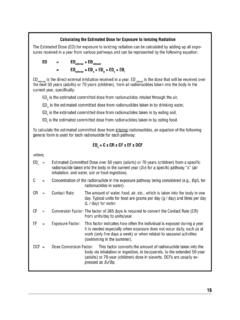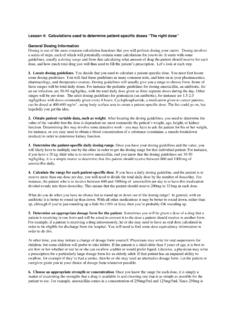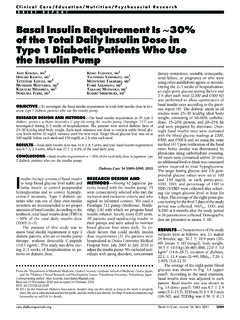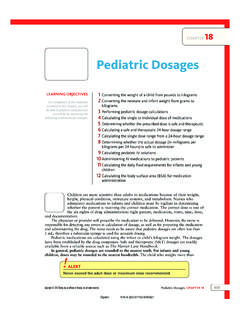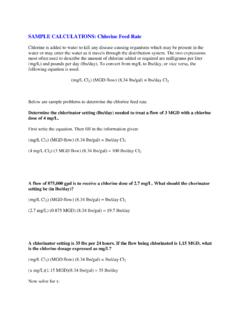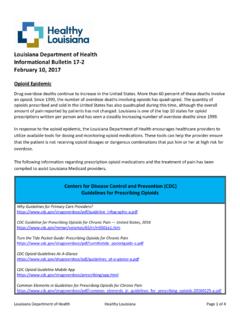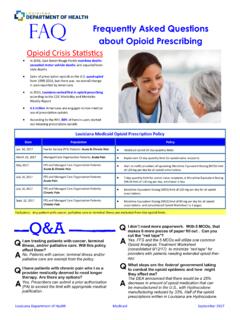Transcription of Programmatic Challenges of Dose Tapering Using SAS®
1 1 Paper 2036-2014 Programmatic Challenges of dose Tapering Using SAS Iuliana Barbalau, Santen Inc., Emeryville, CA Chen Shi, Santen Inc., Emeryville, CA Yang Yang, Santen Inc., Emeryville, CA ABSTRACT: In a good clinical study, statisticians and various stakeholders are interested in assessing and isolating the effect of non-study drugs. One common practice in clinical trials is that clinical investigators follow the protocol to taper certain concomitant medications in an attempt to prevent or resolve adverse reactions and/or to minimize the number of subject withdrawals due to lack of efficacy or adverse event. To assess the impact of those Tapering medicines during study is of high interest to clinical scientists and the study statistician.
2 This paper presents the Challenges and caveats of assessing the impact of Tapering a certain type of concomitant medications Using SAS based on a hypothetical case. The paper also presents the advantages of visual graphs in facilitating communications between clinical scientists and the study statistician. OUTLINE: Introduction Possible Challenges and caveats of Tapering Standardize a medication so that comparison is meaningful SAS steps for achieving standardization Graphs of Tapering medication (step wise graph) Conclusions INTRODUCTION: The focus of this paper will be on presenting challenging situations for assessing the impact of Tapering medication and possible solutions Using SAS software. The Tapering of a medication allows a patient s organism to gradually discontinue a specific medication and reduce the effect an abrupt stop would have.
3 For this article purpose, we will consider Prednisone as our intended Tapering medication. Prednisone is a corticosteroid1. There are medical reasons why it is recommended gradual Tapering of Prednisone. Withdrawal symptoms that could have an impact on subjects are: joint pain, muscle pain, fatigue, headache, fever, low blood pressure, nausea and vomiting. Also, an abrupt discontinuation of treatment in patients who have been on steroid for a prolonged period of time may cause severe symptoms (adrenal crisis, exogenous adrenal insufficiency) due to the fact the normal production of steroids by the body has been turned off2. Let s assume for our fictive Tapering plan, the Tapering regimes should be as follows: 10 mg increments per week when the daily dose is more than 40 mg prednisone, 5 mg increments per week when the Prednisone daily dose is less than 40 mg of prednisone up to 20 mg of prednisone and 1 mg weekly increments afterword s3.
4 The data presented in this article is a fictive one and is not related to an actual study. We will present concomitant medications (steroids) taken by two subjects versus the specified Tapering scheme presented in clinical study protocol. The variables included in the fictive dataset follow CDISC standards and are self-explanatory such as SUBJID (subject ID), CMSEQ (concomitant medication sequence), CMDECOD (concomitant medication coded term), CMDOSTXT (concomitant medication dose ), CMDOSU (concomitant medication unit), CMDOSFRQ (concomitant medication frequency), CMROUTE (concomitant medication route), CMSTDTC (concomitant 1 2,3 2 medication start date), CMSTDY (start day of concomitant medication), CMENDTC (concomitant medication end date), CMENDY (stop day of concomitant medication).
5 Table 1: CM domain (two subjects included) SUBJID CMSEQ CMDECOD CMDOSTXT CMDOSU CMDOS-FRQ CM-ROUTE CMSTDTC CMSTDY CMENDTC CMENDY US100-0001 9 PREDNISOLONE 70 mg QD ORAL 6/4/2012 21 6/10/2012 27 US100-0001 10 PREDNISOLONE 60 mg QD ORAL 6/11/2012 28 6/17/2012 34 US100-0001 11 PREDNISOLONE 50 mg QD ORAL 6/18/2012 35 6/28/2012 45 US100-0001 12 PREDNISOLONE 40 mg QD ORAL 6/29/2012 46 7/4/2012 51 US100-0001 13 PREDNISOLONE 30 mg QD ORAL 7/5/2012 52 7/11/2012 58 US100-0001 16 PREDNISOLONE 20 mg QD ORAL 7/12/2012 59 7/18/2012 65 US100-0001 17 PREDNISOLONE 15 mg QD ORAL 7/19/2012 66 7/25/2012 72 US100-0001 18 PREDNISOLONE 10 mg QD ORAL 7/26/2012 73 8/6/2012 84 US100-0002 2 PREDNISONE 20 mg QD ORAL 1/25/2010 -1100 1/29/2013 1 US100-0002 9 PREDNISONE mg QD ORAL 1/30/2013 2 2/6/2013 9 US100-0002 10
6 PREDNISONE 10 mg QD ORAL 2/7/2013 10 2/14/2013 17 US100-0002 11 PREDNISONE mg QD ORAL 2/15/2013 18 2/22/2013 25 US100-0002 12 PREDNISONE 5 mg QD ORAL 2/23/2013 26 3/2/2013 33 US100-0002 14 PREDNISONE mg QD ORAL 3/3/2013 34 3/10/2013 41 US100-0002 32 PREDNISONE 20 mg QD ORAL 6/26/2013 149 6/26/2013 149 POSSIBLE Challenges AND CAVEATS OF Tapering : Challenges of Tapering medication: 1. Data might be difficult to handle especially in an international clinical trial setting even if the instructions were properly explained and sites have been trained on data collection. Some of the information from the database could be confusing or hard to interpret such as routes, frequencies of medication due to multiple possible ways to prescribe a medication.
7 Language barriers could cause problems with respect to the accuracy of data collection. 2. When the medication is overlapping, the calculation of the daily dose is challenging. There is a need to create a record for each study day and then sum per day the total daily dose . 3. In order to find a meaningful standardization of the medication, a team of people including medical doctors, scientists, statisticians and programmers need to meet several times in order to create a logical algorithm for conversion. The rules for conversions need to be accepted and used across departments by projects leaders and team members. Potential solutions: 1. One possible solution for dataset entry issues would be to send queries to the site to confirm the data is accurate or to correct the data as necessary.
8 This task could be very challenging and would require a lot of manual work. 2. Another option is to add edit checks to verify overlapping medications over specific periods of time, to verify the accuracy of frequency and routes of medication. Unfortunately, if there is a free-text option, an edit check might be hard to implement. 3 3. Creating a Tapering flowchart to be used during the meetings, and to be referenced for converting medication to a standard one. Please see an example of such as Tapering flowchart on next page of this article. 4. If Tapering of medication is specified in the clinical trial protocol, the graph of each subject by site could be used as a tool for assessing the performance of the sites.
9 The sites should be following the protocol instructions with respect to the Tapering of medication. STANDARDIZE A MEDICATION SO THAT COMPARISON IS MEANINGFUL: Subjects enrolled in the study might take medications that need to be tapered. Some of concomitant medications used during clinical trial could be stronger than other medications. To have a meaningful comparison, a standardization of medication is needed. Usually, this type of standardization includes a conversion factor of medication to a standard medication (Prednisone in our case), a conversion of units to standard units. It is highly recommended to use a flowchart as presented in next page. The scheme presented on following page is a useful visual tool for the entire working team, not just for SAS programmers, but also for data management and clinical operations.
10 As per protocol, we need to follow a step down Tapering of the level of Prednisone a subject is taking during a period of time. The standard medication makes the comparison between subjects more manageable. For example, one subject could take 1 mg of Meprednisone, which is stronger than Prednisone, while another subject is taking only 1 mg of Prednisone. Therefore first subject will have mg of Prednisone in his/her body while the second subject will have 1 mg of Prednisone in body at a specific timing. SAS STEPS FOR ACHIEVING STANDARDIZATION: Step 1: In order to achieve standardization, we will make use of formats to help us derive the conversion factors, conversion units and frequencies factors.











